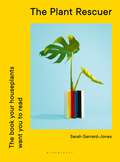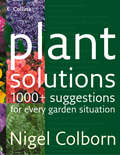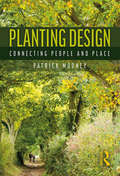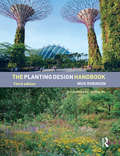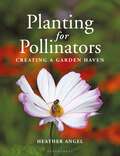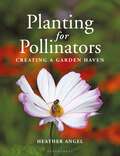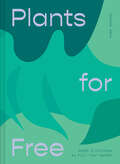- Table View
- List View
The Plant Rescuer: The book your houseplants want you to read
by Sarah Gerrard-JonesA simple, stylish and complete guide for any houseplant ownerWhether you have just one or many houseplants, this is the book they need you to read. It is a clear and practical toolkit on all aspects of plant care from how to choose a plant to tips for everyday care. Changes in your plant's appearance are often a cry for help and this book will help you understand their needs. Learn how to help your plants not only survive but thrive. Sarah, also known as @theplantrescuer, is a self-taught houseplant obsessive who firmly believes every plant deserves a happy life. Her determination to see beyond the 'perfect plant' and to rescue unloved plants makes her the go-to guide.
The Plant Rescuer: The book your houseplants want you to read
by Sarah Gerrard-JonesA simple, stylish and complete guide for any houseplant ownerWhether you have just one or many houseplants, this is the book they need you to read. It is a clear and practical toolkit on all aspects of plant care from how to choose a plant to tips for everyday care. Changes in your plant's appearance are often a cry for help and this book will help you understand their needs. Learn how to help your plants not only survive but thrive. Sarah, also known as @theplantrescuer, is a self-taught houseplant obsessive who firmly believes every plant deserves a happy life. Her determination to see beyond the 'perfect plant' and to rescue unloved plants makes her the go-to guide.
Plant responses (Large print)
by RnibThis page shows three images of a sprouting bean. There is a locator dot shown, which will be at the top left, when the image is the correct way up. The root is to the left and the shoot to the right. In the middle is the rounded shape of the bean. The top image shows the bean when it has just been laid in a dark cupboard. The auxin hormone is evenly spread in the shoot and root. In the second image gravity has caused the auxin to accumulate in the lower half of the shoot and root. In the last image the root has grown more on the side with the least auxin causing it to bend down. The shoot has grown more on the side with the most auxin causing it to bend up. When the root and shoot are vertical the auxin is spread evenly and so the bending stops.
Plant responses (UEB contracted)
by RnibThis page shows three images of a sprouting bean. There is a locator dot shown, which will be at the top left, when the image is the correct way up. The root is to the left and the shoot to the right. In the middle is the rounded shape of the bean. The top image shows the bean when it has just been laid in a dark cupboard. The auxin hormone is evenly spread in the shoot and root. In the second image gravity has caused the auxin to accumulate in the lower half of the shoot and root. In the last image the root has grown more on the side with the least auxin causing it to bend down. The shoot has grown more on the side with the most auxin causing it to bend up. When the root and shoot are vertical the auxin is spread evenly and so the bending stops.
Plant responses (UEB uncontracted)
by RnibThis page shows three images of a sprouting bean. There is a locator dot shown, which will be at the top left, when the image is the correct way up. The root is to the left and the shoot to the right. In the middle is the rounded shape of the bean. The top image shows the bean when it has just been laid in a dark cupboard. The auxin hormone is evenly spread in the shoot and root. In the second image gravity has caused the auxin to accumulate in the lower half of the shoot and root. In the last image the root has grown more on the side with the least auxin causing it to bend down. The shoot has grown more on the side with the most auxin causing it to bend up. When the root and shoot are vertical the auxin is spread evenly and so the bending stops.
Plant Solutions
by Nigel ColbornPlant Solutions is a brand new contemporary problem-solving guide to finding the right plant for the right place in your garden. Packed with plant suggestions, cultivation notes and companion ideas, Plant Solutions helps you create a suitable and successful planting scheme by finding plants to suit your garden’s needs.
Plant User Handbook: A Guide to Effective Specifying
by James Hitchmough Ken FieldhouseProfessional landscapers and all those involved in creating green spaces have long been in need of a book that is a guide to plant specification, but also makes sense of plants and their cultivation. Plant User Handbook is for practitioners who are professionally engaged in the use of plants in public, commercial and institutional landscapes. Planting schemes are undertaken on the basis of a binding contract – generally between the client (who owns or leases the landscape) and the implementer (the landscape contractor), with the designer acting both as specifier and contract administrator. Within this contractual relationship, planting schemes must be implemented to an agreed timetable. To manage this procedure efficiently, landscape designers and managers need quick access to the factual and scientific background for practical planting design and its implementation through specification writing and contracts. The book covers over 20 well defined topics, and is written by leading experts in the industry. It is arranged into five sections: Preliminaries to plant use and the landscape Managing plant growth on landscape sites Establishment and management of trees Establishment and management of smaller woody plants Establishment and management of herbaceous plants Carefully illustrated with diagrams, black and white photographs and colour plates, this handbook provides a unique resource for professionals wanting to improve their specification skills, as well as to explore creative approaches to design and practical implementation.
Planting: A New Perspective
by Piet Oudolf Noel KingsburyPlanting: A New Perspective, by famed landscape architects Piet Oudolf and Noel Kingsbury, characterizes a groundbreaking moment in modern horticulture; the first book to share Oudolf&’s original planting plans and the only book to explicitly guide gardeners through how Oudolf's iconic landscapes are made.
Planting a Paradise: A year of pots and pollinators
by Arthur ParkinsonSelected for The Times Best Gardening Books of the Year 2023Every garden, large or small, in a town or in the country, even one formed completely by pots, can be a living dance of lavish colours, glorious scents and pollen-rich flowers alive to the sound of bird song and the buzz of bees. In Planting a Paradise, Arthur Parkinson, bestselling author of The Flower Yard, focuses on what to grow through the seasons with an array of planting ideas and recommended varieties to inspire the experienced and novice gardener alike. From his newly found love of muscari, narcissi and seeding grasses, to circuses of dahlias, luscious herbs, figs and crab apples, the result is not only a stunning living harvest but also an oasis for wildlife at a time when we need this style of gardening more than ever. Praise for The Flower Yard:'Simply gorgeous' - Nigel Slater'The Kew-trained king of the small-space garden' - Guardian
Planting Design: Connecting People and Place
by Patrick MooneyLandscape designers have long understood the use of plants to provide beauty, aesthetic pleasure and visual stimulation while supporting a broad range of functional goals. However, the potential for plants in the landscape to elicit human involvement and provide mental stimulation and restoration is much less well understood. This book meshes the art of planting design with an understanding of how humans respond to natural environments. Beginning with an understanding of human needs, preferences and responses to landscape, the author interprets the ways in which an understanding of the human-environment interaction can inform planting design. Many of the principles and techniques that may be used in planting design are beautifully illustrated in full colour with examples by leading landscape architects and designers from the United Kingdom, Europe, North America and Asia, including: Andrea Cochran, Andrea Cochran Landscape Architecture, San Francisco, CA Design Workshop Inc. Richard Hartlage, Land Morphology, Seattle, WA Shunmyo Masuno, Japan Landscape Consultants Ltd., Yokohama Piet Oudolf, Hummelo, The Netherlands Melody Redekop, Vancouver Christine Ten Eyck, Ten Eyck Landscape Architects Inc., Austin, TX Kongjian Yu, Turenscape Ltd., Beijing. The book stimulates thought, provides new direction and assists the reader to find their own unique design voice. Because there are many valid processes and intentions for landscape design, the book is not intended to be overly prescriptive. Rather than presenting a strict design method and accompanying set of rules, Planting Design provides information, insight and inspiration as a basis for developing the individual designer’s own expression in this most challenging of art forms.
Planting Design: Connecting People and Place
by Patrick MooneyLandscape designers have long understood the use of plants to provide beauty, aesthetic pleasure and visual stimulation while supporting a broad range of functional goals. However, the potential for plants in the landscape to elicit human involvement and provide mental stimulation and restoration is much less well understood. This book meshes the art of planting design with an understanding of how humans respond to natural environments. Beginning with an understanding of human needs, preferences and responses to landscape, the author interprets the ways in which an understanding of the human-environment interaction can inform planting design. Many of the principles and techniques that may be used in planting design are beautifully illustrated in full colour with examples by leading landscape architects and designers from the United Kingdom, Europe, North America and Asia, including: Andrea Cochran, Andrea Cochran Landscape Architecture, San Francisco, CA Design Workshop Inc. Richard Hartlage, Land Morphology, Seattle, WA Shunmyo Masuno, Japan Landscape Consultants Ltd., Yokohama Piet Oudolf, Hummelo, The Netherlands Melody Redekop, Vancouver Christine Ten Eyck, Ten Eyck Landscape Architects Inc., Austin, TX Kongjian Yu, Turenscape Ltd., Beijing. The book stimulates thought, provides new direction and assists the reader to find their own unique design voice. Because there are many valid processes and intentions for landscape design, the book is not intended to be overly prescriptive. Rather than presenting a strict design method and accompanying set of rules, Planting Design provides information, insight and inspiration as a basis for developing the individual designer’s own expression in this most challenging of art forms.
The Planting Design Handbook
by Nick RobinsonSince the first edition was published in 1992, Nick Robinson's The Planting Design Handbook has been widely used as a definitive text on landscape architecture courses throughout the world. It remains one of the few titles written by a practicing landscape architect and educator who is also a horticulturalist and accomplished plantsman, and which deals with the application of planting design on a large scale in landscape architecture and urban design projects. The Planting Design Handbook is distinctive for its elegant integration of an ecological approach with an understanding of visual and spatial composition. It emphasizes the role of vegetation layers and designed plant communities in complex and diverse plant assemblages for all kinds of sites and uses. This expanded and comprehensively updated third edition still provides a complete examination of principles and practice of design for public, institutional and private landscapes. It takes account of developments in theory and practice, especially in the use of perennials, and reflects a variety of media and approaches current in landscape architecture and design. All chapters have been revised and re-written to ensure updated references and new references have been added. Many new photographs of planting and projects around the world have been included, with examples of current professional drawings to illustrate the design process. It is generously illustrated, including a colour section and the beautifully detailed line drawings of the Chinese architect and painter Jia-Hua Wu.
The Planting Design Handbook
by Nick RobinsonSince the first edition was published in 1992, Nick Robinson's The Planting Design Handbook has been widely used as a definitive text on landscape architecture courses throughout the world. It remains one of the few titles written by a practicing landscape architect and educator who is also a horticulturalist and accomplished plantsman, and which deals with the application of planting design on a large scale in landscape architecture and urban design projects. The Planting Design Handbook is distinctive for its elegant integration of an ecological approach with an understanding of visual and spatial composition. It emphasizes the role of vegetation layers and designed plant communities in complex and diverse plant assemblages for all kinds of sites and uses. This expanded and comprehensively updated third edition still provides a complete examination of principles and practice of design for public, institutional and private landscapes. It takes account of developments in theory and practice, especially in the use of perennials, and reflects a variety of media and approaches current in landscape architecture and design. All chapters have been revised and re-written to ensure updated references and new references have been added. Many new photographs of planting and projects around the world have been included, with examples of current professional drawings to illustrate the design process. It is generously illustrated, including a colour section and the beautifully detailed line drawings of the Chinese architect and painter Jia-Hua Wu.
The Planting Design Handbook
by Nick RobinsonSince the first edition was published in 1992, Nick Robinson's The Planting Design Handbook has been widely used as a definitive text on landscape architecture courses throughout the world. It remains one of the few titles written by a practicing landscape architect and educator who is also a horticulturalist and accomplished plantsman, and which deals with the application of planting design on a large scale in landscape architecture and urban design projects. The Planting Design Handbook is distinctive for its elegant integration of an ecological approach with an understanding of visual and spatial composition. It emphasizes the role of vegetation layers and designed plant communities in complex and diverse plant assemblages for all kinds of sites and uses. This expanded and comprehensively updated third edition still provides a complete examination of principles and practice of design for public, institutional and private landscapes. It takes account of developments in theory and practice, especially in the use of perennials, and reflects a variety of media and approaches current in landscape architecture and design. All chapters have been revised and re-written to ensure updated references and new references have been added. Many new photographs of planting and projects around the world have been included, with examples of current professional drawings to illustrate the design process. It is generously illustrated, including a colour section and the beautifully detailed line drawings of the Chinese architect and painter Jia-Hua Wu.
The Planting Design Handbook
by Nick RobinsonSince the first edition was published in 1992, Nick Robinson's The Planting Design Handbook has been widely used as a definitive text on landscape architecture courses throughout the world. It remains one of the few titles written by a practicing landscape architect and educator who is also a horticulturalist and accomplished plantsman, and which deals with the application of planting design on a large scale in landscape architecture and urban design projects. The Planting Design Handbook is distinctive for its elegant integration of an ecological approach with an understanding of visual and spatial composition. It emphasizes the role of vegetation layers and designed plant communities in complex and diverse plant assemblages for all kinds of sites and uses. This expanded and comprehensively updated third edition still provides a complete examination of principles and practice of design for public, institutional and private landscapes. It takes account of developments in theory and practice, especially in the use of perennials, and reflects a variety of media and approaches current in landscape architecture and design. All chapters have been revised and re-written to ensure updated references and new references have been added. Many new photographs of planting and projects around the world have been included, with examples of current professional drawings to illustrate the design process. It is generously illustrated, including a colour section and the beautifully detailed line drawings of the Chinese architect and painter Jia-Hua Wu.
Planting Design: A New Naturalism (Workshops on Garden Design)
by Catherine Heatherington Juliet SargeantAimed at professional and novice garden and landscape designers; covers the background history and design consideration of naturalistic planting. Architecture (Landscape) & Town Planning; gardening
Planting Design: Seaside and Shelter (Workshops on Garden Design)
by Deborah JolleyDesigning a garden by the sea poses special problems for the designer. High winds and salt spray can wreak havoc with planting schemes, and the need to provide sheltered areas for sitting and entertaining may be difficult to achieve. On the positive side, the proximity of the sea greatly reduces the chances of damaging spring frosts, so the designer may choose from a far wider palette of plants than is possible further inland, including the exotic and sub-tropical species currently in vogue. A balance between providing sufficient shelter to satisfy the client's needs and allowing views to the sea to be maintained and enhanced, is the challenge facing every designer. The book explains the particular process of analysis needed for maritime environments, the effects of wind and salt spray and the microclimates created by sea and wind. The establishment and maintenance of shelter belts is fully explained, together with practical information about the choice and implementation of planting schemes. A suggested list of suitable plants for windswept sites is included. Each chapter is accompanied by case studies of actual coastal gardens.
Planting for Pollinators: Creating a Garden Haven
by Ms Heather AngelPlanting for Pollinators is an easy-to-use gardening guide to help you encourage different types of insect pollinators into your garden.Insect pollinators not only bring joy to our gardens, they also provide an essential service for our planet. Without bees, flies, hoverflies, butterflies, moths and beetles, some of our favourite foods, flowers and plants would cease to exist. Whether you have a large garden, an urban balcony or just a window box, planting to encourage pollinators is a fantastic and surprisingly easy first step in creating a wildlife-friendly space. Planting for Pollinators features a wide range of plants, with guidance on the best ways to nurture lawns and verges, pollinator predation and tips on watching and photographing wildlife. Beautifully illustrated throughout with images from award-winning wildlife photographer Heather Angel, this essential guide will show you how plants communicate with insects, and why it's so important to protect our pollinators. Organised by season and featuring more than 100 plant species – including bulbs, annuals, perennials, shrubs and climbers – this practical guide will help you to discover the short- and long-term benefits of having a variety of pollinators visit your garden.
Planting for Pollinators: Creating a Garden Haven
by Ms Heather AngelPlanting for Pollinators is an easy-to-use gardening guide to help you encourage different types of insect pollinators into your garden.Insect pollinators not only bring joy to our gardens, they also provide an essential service for our planet. Without bees, flies, hoverflies, butterflies, moths and beetles, some of our favourite foods, flowers and plants would cease to exist. Whether you have a large garden, an urban balcony or just a window box, planting to encourage pollinators is a fantastic and surprisingly easy first step in creating a wildlife-friendly space. Planting for Pollinators features a wide range of plants, with guidance on the best ways to nurture lawns and verges, pollinator predation and tips on watching and photographing wildlife. Beautifully illustrated throughout with images from award-winning wildlife photographer Heather Angel, this essential guide will show you how plants communicate with insects, and why it's so important to protect our pollinators. Organised by season and featuring more than 100 plant species – including bulbs, annuals, perennials, shrubs and climbers – this practical guide will help you to discover the short- and long-term benefits of having a variety of pollinators visit your garden.
Planting in a Post-Wild World: Designing Plant Communities for Resilient Landscapes
by Thomas Rainer Claudia WestA richly illustrated and comprehensive guide to creating ecologically healthy landscapes that emulate nature from two of the leading names in landscape architecture.
Planting Plans For Your Kitchen Garden: How to Create a Vegetable, Herb and Fruit Garden in Easy Stages
by Holly FarrellPlanting Plans for Your Kitchen Garden gives you all you need to turn your back garden into a productive paradise with modular planting plans for simple beds of vegetables, herbs, fruit and cut flowers. You can also mix and match the beds to create your own kitchen garden or allotment.
Planting the Natural Garden
by Piet Oudolf Henk GerritsenFans of Piet Oudolf will revel in this updated edition of the book that helped launch his career.
Planting with Nature: A Guide to Sustainable Gardening
by Kirsty Wilson Hazel FranceBy reimagining how we design and use our gardens, we can all do our bit to support local wildlife, improve our health and help tackle the climate crisis. If we all take positive steps in our gardens, no matter how small, we can all really make a difference in the world.This book focuses on the activities and planting suitable for a Scottish climate but also contains lots of useful information relevant for gardeners throughout the UK. Practical information on planning is followed by expert guidance on:Planting for wildlife in nectar-rich borders, wildflower meadows, hedgerows, trees and shrubsBuilding for wildlife with bird boxes, bug boxes, feeders and pondsGreen gardening approaches with fruit and veg production, rain gardens, green roofs, compost making and creating new plants through propagationAttracting birds, bees, butterflies and other insects, aquatic life and nightlife
Plants for Free: Seeds And Cuttings To Fill Your Garden
by Sharon AmosIn this book, Sharon Amos explains how to design and create a beautiful garden for little or no money, offering tips on bartering for clippings, getting a bargain at garage sales or neighbourhood fairs, digging up suckers or adapting wild species and controlling them in a garden environment.
Plants for Soil Regeneration: An Illustrated Guide
by Sally Pinhey Margaret TebbsThis book is a comprehensive, beautifully illustrated colour guide to the plants which farmers, growers and gardeners can use to improve soil structure and restore fertility without the use and expense of agrichemicals. Information based on the latest research is given on how to use soil conditioning plants to avoid soil degradation, restore soil quality and help clean polluted land. There are 11 chapters: 1 to 6 cover soil health, nitrogen fixation, green manures and herbal leys, bacteria and other microorganisms, phytoremediators and soil mycorrhiza (plant-fungal symbiosis). Chapter 7 has plant illustrations, with climate range and soil types, along with their soil conditioning properties and each plant is presented with a comprehensive description opposite a detailed illustration, in full colour. Chapters 8 to 10 examine soil stabilisers, weeds and invasive plants, and hedges and trees and the final chapter, contains 5 case studies with the most recent data, followed by an appendix and glossary. The book allows the reader to identify the plants they need quickly and find the information necessary to begin implementation of soil regeneration.
